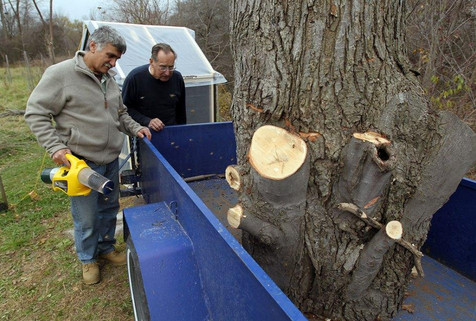 The company contracted to do site preparation work for the new Canadian inspection plaza got quite a “buzz” when they discovered a large bee hive which was literally wrapped around the trunk of a maple tree some 15 feet above the ground.
The company contracted to do site preparation work for the new Canadian inspection plaza got quite a “buzz” when they discovered a large bee hive which was literally wrapped around the trunk of a maple tree some 15 feet above the ground.
Unlike other insects which either migrate or avoid cold by burrowing in soil or moving indoors, honeybees live in hives throughout the winter actively keeping the nest warm and living off a large cache of stored food. While a colony is much smaller during the winter months than it is in the summer, a hive will still number in the thousands.
Workers with Columbia Utility Services Inc. needed to remove the tree but were concerned about the future of the colony and enlisted the help of beekeepers to safely remove the large hive.
Saving the hive was no easy task. Workers had to first wait for a cool morning when most of the estimated 40,000 bees were not active. Then, with the help of an aerial bucket and two beekeepers, they covered the hive so the bees would not escape and cut a six foot section of a tree trunk and lowered it to the ground. The 2,000 pound tree trunk was moved by crane to a trailer and taken to Lasalle.
Honeybees are perhaps the most important pollinator operating in the Canadian agricultural industry. Many of the plants that honeybees help to foster provide seeds, fruit, and nuts that also feed numerous animal species native to Canada. With the decline in bee populations (some entomologists have estimated that last year’s cold winter killed off more than 30 per cent of the honey bees in the province) the extraordinary effort in saving this hive was simply the right thing to do.

